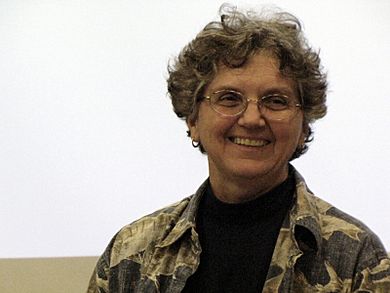Vicki Funk facts for kids
Quick facts for kids
Vicki Funk
|
|
|---|---|

Funk in 2010
|
|
| Born |
Vicki Ann Funk
November 26, 1947 Owensboro, Kentucky, U.S.
|
| Died | October 22, 2019 (aged 71) |
| Alma mater | B.S., Murray State University, Biology and History, 1969, M.S., Murray State University, Biology, 1975; PhD, Ohio State University, 1980 |
| Known for | Botanist and curator |
| Awards |
|
| Scientific career | |
| Institutions | New York Botanical Garden, Smithsonian Institution, George Mason University, Duke University |
| Theses |
|
| Author abbrev. (botany) | V.A.Funk |
Vicki Ann Funk (November 26, 1947 – October 22, 2019) was an American botanist. A botanist is a scientist who studies plants. She worked as a curator at the Smithsonian's National Museum of Natural History. A curator manages collections, like plants in a museum. Vicki Funk was known for her work on the composite family of plants, called Asteraceae. She collected plants all over the world. She also studied how different plant species are related and how they spread across the Earth.
Contents
Life and Education
Vicki Funk was born on November 26, 1947, in Owensboro, Kentucky. Her parents were Edwin Joseph and Betty Ann Funk. She had two brothers, Edwin Jr. and Jared Kirk. Vicki grew up in Owensboro and lived on a few United States Air Force bases when she was very young.
College Years
Vicki studied biology and history at Murray State University in Kentucky. She earned a Bachelor of Science degree in 1969. She first thought about going to medical school. However, after volunteering at a hospital, she decided it wasn't for her.
After college, she lived and worked in Germany for two years. Then she came back to the United States. She taught high school for one year. Later, she spent a summer at the Hancock Biological Station. There, she discovered her love for field work and scientific research.
Graduate Studies
In 1975, Vicki earned her Master of Science (M.S.) degree in Biology from Murray State. Her research was about plants and geology in Calloway County, Kentucky. She then began her PhD studies at Ohio State University. She focused on the Compositae family, which is another name for the Asteraceae.
In 1980, she received her Ph.D. from Ohio State. Her doctoral research was about the Montanoa group of plants. After her Ph.D., she spent a year at the New York Botanical Garden. There, she studied the Compositae and a new field called phylogenetics. This field looks at the evolutionary relationships between living things.
Career at the Smithsonian
In 1981, Vicki Funk became a research scientist and curator at the U.S. National Herbarium. This is part of the Smithsonian Institution's National Museum of Natural History. In 2004, she became a Senior Research Scientist and Curator of Compositae.
Plant Research and Discovery
Vicki's research focused on understanding how plants evolved. She also studied how they spread geographically. She used plant DNA to figure out these relationships. She helped discover a very rare plant called Bidens meyeri in Rapa Iti, French Polynesia. Her work showed that this plant might have traveled from North America to the Austral Islands.
Leading Important Programs
Starting in 1988, Vicki led the Biological Diversity of the Guiana Shield Program (BDG). This program studies the amazing variety of life in a region of South America. In 2015, she started the Global Genome Initiative for Gardens. Both programs are based at the Smithsonian Institution. She also taught as a professor at George Mason University and Duke University.
Involvement in Scientific Societies
Vicki was a member of many scientific groups. She also served as president for several of them. These included the Society of Systematic Biologists and the American Society of Plant Taxonomists. She was also president of the International Biogeography Society.
Awards and Recognition
Vicki Funk received many awards for her important work.
Major Awards
- In 2001, she received a Queensland Research Fellowship from the government of Queensland, Australia.
- In 2009, she earned two awards from the Smithsonian. These were for her science achievements and for working well with others.
- In 2010, she won the Stebbins' Medal. This award is for the best publication in plant systematics or evolution.
- In 2012, she won the Smithsonian's Secretary's Award for Outstanding Publication.
- In 2014, she received the Rolf Dahlgren Prize. This was for her big contributions to understanding how flowering plants evolve.
Lifetime Achievements
Vicki was also honored for her entire career.
- In 2018, she won the Asa Gray Lifetime Achievement Award. This is a very high honor from the American Society of Plant Taxonomists.
- In 2019, the Linnean Society of London gave her the Linnean Medal. This award recognizes a lifetime of service to natural sciences.
- Also in 2019, the American Society of Plant Taxonomists created the Vicki Funk Fund. This fund helps graduate students with their research.
Species Named After Her
Scientists have named several species after Vicki Funk to honor her.
- In 2005, a new species of ant, Pheidole funki, was named after her. It was found in Guyana.
- Two plant groups, Vickia and Vickifunkia, were named in her honor. These are part of the Compositae family.
- The plant Xenophyllum funkianum from the Andes mountains was named after her in 2020.
- Baccharis funkiae, a rare plant from Uruguay, is also named after Vicki Funk.
- Indian botanists named a new plant species, Didymocarpus vickifunkiae, to honor her contributions.
In November 2020, a special issue of the Journal of Systematics and Evolution was dedicated to Vicki Funk. It celebrated her work in plant systematics and biogeography.
See also
 In Spanish: Victoria Ann Funk para niños
In Spanish: Victoria Ann Funk para niños

